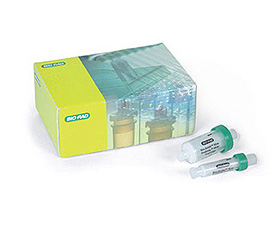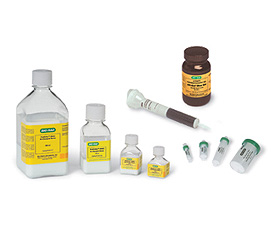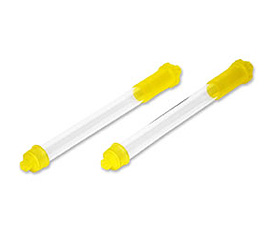Affinity Columns
Prepacked affinity columns are available for gravity flow and low-pressure systems with a range of different types of affinity resins. Bio-Rad offers three major types of affinity media:
- Profinity™ media for the purification of affinity-tagged proteins
- Affi-Gel® and Affi-Prep® media for laboratory-scale and process-scale affinity purifications
- UNOsphere SUPrA™ Protein A media for antibody purification
Native IMAC and GST affinity purification kits are also available, including affinity columns, buffers, and desalting columns for a complete affinity-tagged protein purification workflow solution.
Affinity Media
Bio-Rad offers a range of different types of affinity media. The resins are available either prepacked into different types of columns or in bulk for you to pack into columns by hand or use in bulk protocols. Affinity media are available for both laboratory- and process-scale purifications. The most common types of chromatography using affinity media are the purification of recombinant proteins or antibodies.
The majority of recombinant proteins have either a polyhistidine tag, usually hexahistidine, or a glutathione-S-transferase (GST) fusion tag. Histidine tags bind to divalent or trivalent metal ions that are immobilized on the affinity column. This is known as immobilized metal affinity chromatography, or IMAC. The most common metal used for the generation of IMAC affinity media is nickel, although copper, zinc, and cobalt are also used. Resins are available either charged with nickel or uncharged, allowing for your choice of a different metal. Generally, imidazole is used as the competing ligand for elution from IMAC affinity media. For GST fusion proteins, the tripeptide glutathione (Glu-Cys-Gly) is the immobilized ligand. Excess reduced glutathione is used to elute protein tagged with GST.
Protein A, a protein found on the surface of Staphylococcus aureus, binds a range of immunoglobulins in many species. The use of Protein A affinity media provides a fast and easy way to purify antibodies from serum, ascites, and media. Elution of antibodies from a Protein A affinity column is usually by a low-pH mobile phase with a high concentration of an amino acid such as glycine or arginine.
Other frequently used affinity column immobilized ligands include:
- DEAE for purification of immunoglobulin G (IgGs)
- Cibacron Blue F3GA and CM for purification of immunoglobulins
- Cibacron Blue F3GA for nucleotide-binding enzymes
- Polymixin for endotoxin removal
- Boronate for cis-hydroxyl–containing molecules including nucleotides, glycopeptides, and sugars
Affinity Column Chromatography
Affinity column chromatography is based on the high affinity of a ligand immobilized on a stationary phase with one or more molecules in a sample. The interaction between the binding partners is reversible. The bound partner from the sample is eluted from the affinity column by changing the composition of the mobile phase, usually by including a molecule that competes for binding with the immobilized ligand.
The high level of specificity of the interaction between the immobilized ligand and the target can often allow for one-step purification (although depending on the intended downstream use, desalting may be necessary). Affinity columns can be used in a number of different types of protocols. The most common uses are:
- Purification of a molecule or complex from a heterogeneous sample
- Removal of a molecule or complex from a sample
- Concentration of a molecule or complex from a dilute sample



